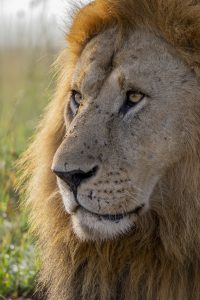A safari in Tanzania is a once-in-a-lifetime adventure—an immersion into the raw, untamed beauty of Africa. But once the excitement kicks in, one big question usually follows:
Should you plan around the iconic Great Migration, or opt for a classic safari experience that’s available year-round?
Both options offer incredible wildlife encounters and unforgettable landscapes, but they differ in timing, budget, atmosphere, and pace. This guide will walk you through the key differences—and help you figure out which type of safari experience best suits your travel style, interests, and season.
What Is a Regular Safari in Tanzania?
A regular safari is what most travelers experience when visiting Tanzania’s legendary Northern Circuit, without specifically chasing the Great Migration. These safaris deliver diverse, year-round wildlife, incredible scenery, and often fewer crowds.
Top Parks for a Regular Safari
Serengeti National Park (Central & Southern)
Even without the migrating herds, the Serengeti is home to lions, leopards, cheetahs, hyenas, elephants, buffalo, and more. Predator sightings are consistent all year, especially in Central Serengeti.


Ngorongoro Crater
A natural wildlife amphitheater and UNESCO World Heritage Site, it’s home to black rhinos, hippos, lions, elephants, and flamingos—all within a dramatic collapsed volcano.
Tarangire National Park
Ideal during the dry season (June–October), Tarangire shines for its elephant herds, baobab forests, and less-touristed feel.
Lake Manyara National Park
Small but packed with biodiversity: flamingos, hippos, baboons, and tree-climbing lions—perfect for families or shorter drives.
Beyond the Northern Circuit
Western Tanzania: For real wilderness and primates, Katavi (for isolation) and Mahale Mountains (for chimp trekking) are unparalleled.
Southern Tanzania: Ruaha National Park and Nyerere (Selous) Game Reserve offer a more remote, off-the-grid experience with fewer tourists.

What Is a Great Migration Safari?
The Great Migration is one of nature’s most dramatic spectacles. Over 1.5 million wildebeest, along with hundreds of thousands of zebras and gazelles, move in a vast circle through the Serengeti and into Kenya’s Maasai Mara, following the rains and fresh grazing.
It’s intense, unpredictable, and awe-inspiring.
Migration Highlights by Season:
- January–March: Calving season in the southern Serengeti (Ndutu) – thousands of baby wildebeest born in weeks; predators close behind.
- April–June: Herds migrate northwest toward the Grumeti River.
- July–October: Iconic Mara River crossings in Northern Serengeti—this is where the high-drama scenes of wildebeest leaping into crocodile-infested waters unfold.
- November–December: Herds return to the south as the rains revive fresh grassland.
Key Differences at a Glance
| Feature | Regular Safari | Great Migration Safari |
| Timing | Year-round | Seasonal (based on herd movement) |
| Wildlife | Diverse and reliable | Mass movement, high predator-prey drama |
| Cost | More budget-friendly | Higher prices during peak periods |
| Crowds | Less crowded | Busy during river crossings (Jul–Oct) |
| Planning | Flexible | Requires timing and advance booking |
Can You Combine Both?
Absolutely. Many travelers start with classic parks like Tarangire or Ngorongoro, then finish in Serengeti during a migration highlight (like calving season or river crossings). Mobile tented camps even follow the herds, allowing you to get as close as possible to the action—without sacrificing comfort.

Which Safari is Best for You?
If You’re Traveling as a Family
Best bet: Regular Safari
Families benefit from shorter drives, easier logistics, and less rigid planning. Parks like Tarangire, Lake Manyara, and Ngorongoro offer variety, comfort, and reliable wildlife without needing to chase the herds.
If your children are older and can handle longer days, combining this with a calving season safari in Ndutu (Jan–Mar) is a great middle ground—short distances, baby animals, and lower costs.
If You’re a Couple or on Honeymoon
Best bet: Either—depending on mood
Couples looking for romance, privacy, and relaxation may prefer a regular safari in quieter parks during shoulder season. For those craving high-drama sightings, a Great Migration safari—especially in the Mara or Ndutu—is unforgettable.
If You’re Traveling Solo
Best bet: Great Migration (in a group tour) or Regular Safari (for flexibility)
Solo travelers often join group safaris during migration season to split costs. Regular safaris, especially during green or shoulder seasons, are great for solitude, self-reflection, and value.
What Else Should You Consider?
Climate and Comfort
- Dry season = cooler mornings, fewer insects, better visibility
- Green season = warmer days, lush landscapes, occasional rains
Safari Style & Transport
- Migration safaris may involve fly-in access and mobile tented camps.
- Regular safaris often include road-based travel and more permanent lodges.
Photography
- Migration safaris = action and drama
- Regular safaris = slower pacing, better light control, fewer vehicles in frame
Accommodation Type
- Migration-focused camps tend to be mobile and more rustic (but immersive)
- Regular safaris offer more variety: lodges with pools, family rooms, and stable electricity
Health Considerations
- More mosquitoes during green season; bring repellent and consider antimalarials
- Tsetse flies more common in Tarangire and Selous—light-colored clothes help
Cultural Experiences
- Regular safaris allow more time for Maasai village visits, crater rim walks, or local markets
- Migration safaris tend to be tightly focused on game drives
Conservation Impact
- Migration hotspots face heavy seasonal traffic
- Visiting lesser-known parks or traveling off-peak spreads tourism benefits and reduces environmental strain

Final Thoughts: It’s Not a Competition—It’s About Fit
The Great Migration delivers unmatched spectacle—giant herds on the move, predator-prey drama, river crossings that feel straight out of a nature documentary. But it requires planning, budget flexibility, and the willingness to share space with more travelers.
A regular safari, on the other hand, is steady, versatile, and often more relaxed—offering just as much beauty, with a bit more breathing room.
Whichever path you choose, Tanzania will reward you with wildlife, wonder, and moments you’ll never forget.
Want help creating your ideal itinerary—whether it’s timing the migration or savoring the year-round magic of the Northern Circuit? Let’s plan a safari that fits your story.



